Guitar World Verdict
If the purpose of a copy is to provide a taste of the real thing at a way more affordable price point then both these V100s pass that test in some style.
Pros
- +
Tidy build for the price.
- +
Acceptable price.
- +
Some stylish tones.
Cons
- -
Control circuit could be better.
- -
The PBB's stacked humbuckers don't capture a true P-90 voice.
- -
The MP is not the most subtle single-cut we've ever heard.
You can trust Guitar World
When Vintage was conceived back in 1996 by UK distributor John Hornby Skewes (JHS), the new company annoyed people from the start with that name. “They’re not vintage!” Of course not – affordability and familiarity were always the plan.
JHS might have had the last laugh, however: we’re told that Vintage electric guitars are now available in over 130 countries worldwide, not least the USA. The guitars have had considerable input from designer Trev Wilkinson, though JHS’s operations director, Paul Smith, comments that Trev’s “consultancy agreement with JHS expired in August 2018 after 12 amazing years working together developing the Vintage ranges. We continue to specify Wilkinson hardware on our Vintage models and co-operate regarding specific hardware and parts for new models.”
No-one is pretending that Vintage is riding a wave of innovation (although the short-lived Vintage Advance series certainly had a go at that) and as a consequence the company has ridden run-ins with Gibson, most recently a legal dispute that was settled in 2017. “The terms of the settlement remain confidential,” offers Paul. “Suffice to say that we can offer the guitar body shapes that Vintage produce, for sale, worldwide.”
As a result, Vintage offers quite a substantial range of Gibson-inspired single- and double-cutaway classic-style guitars that retail under £500. No, these models won’t be challenging Gibson Custom any time soon. But, on paper at least, they offer considerable value for money: a serious starter electric or, as likely, a gigging spare or potential modding chassis.
As with the design by which they’re inspired, both V100s are weighty propositions, but they feel perfectly good in terms of playability
Our two V100s were launched at the start of the year. The V100MP was initially launched as “an electrified tribute” to Mick Ronson of Bowie’s fabled Spiders From Mars. “The V100MRN [as it was originally called] calls to mind images of glam-rock rebels and eight-legged outer space travellers,” says the PR.
Perhaps someone had a problem with the Ronno connection and, quietly, the V100MRN became the VP100MP with no mention of the late, great guitarist. Ronson’s Spiders-era axe was a stripped-front Gibson Les Paul Custom circa 1968 with its famously mismatched control knobs – a feature replicated here, although the ‘wrong’ tone knobs should really be those black ribbed witch-hat style knobs.
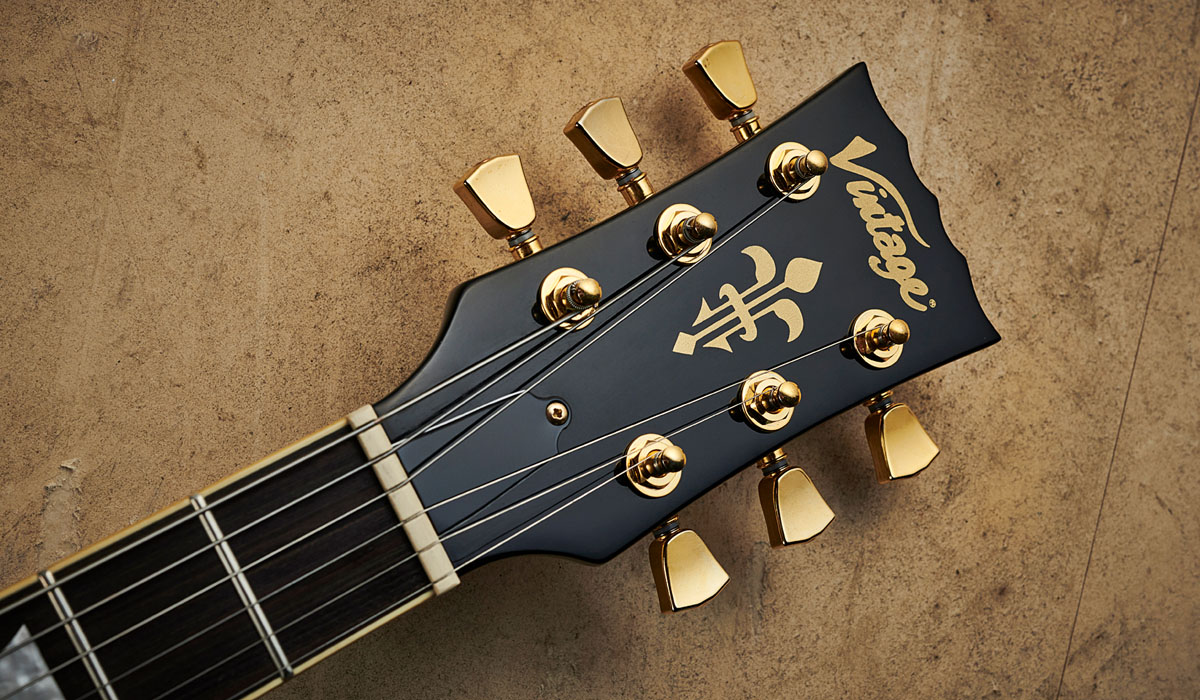
The other new V100 model we have on review, the PBB, appears to take the first version of the Les Paul Custom circa 1954 to ’57 as its inspiration. But they are not Gibson Les Pauls. They have the wrong shape headstock complete with the wrong logo, the ‘wrong’ outline, and are made in Asia, not the USA. Neither guitar bears any specific ‘Country Of Origin’ mark and Paul Smith simply states “we use production facilities in both China and Vietnam”.
All the latest guitar news, interviews, lessons, reviews, deals and more, direct to your inbox!
First impressions are of a pair of slightly on the heavy side single-cuts that are extremely well finished, highly glossed and for the most part very well detailed. The cream edge binding with its inner black striped purfling surrounds both the top and back edges, Les Paul Customstyle. The all-black PBB, therefore, does look extremely classy (a few marks on the fingerboard binding in front of the neck pickup excepted).
The top carve is very nicely dished and a couple of millimetres thicker than our Gibson reference at 62mm from top to back. The shape is clearly close, but compare it with an original and you’ll quickly note the thinner treble horn and the slightly rounded top shoulder, which, on the back, flows into the cutaway, including the binding, and leaves the heel platform slightly thinner. Less obviously, the lower waist is slightly less rounded.
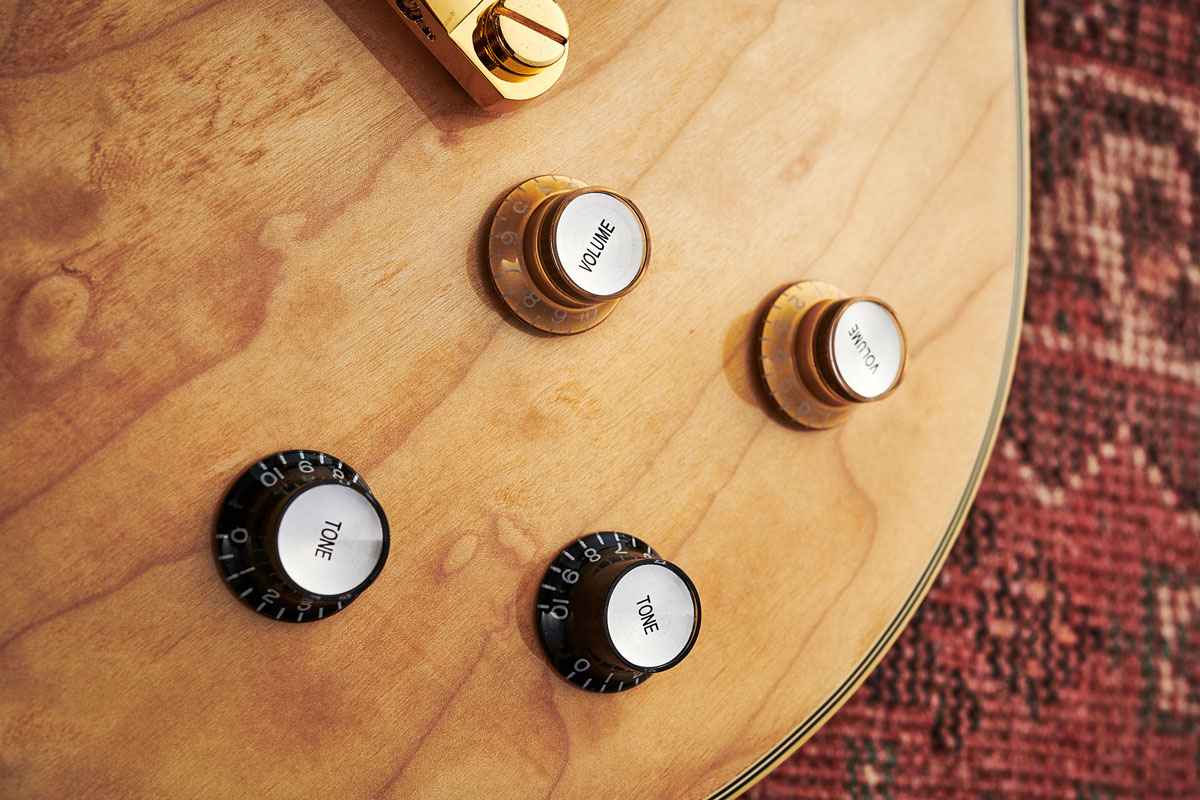
Originally intended as a tribute to Mick Ronson, the V100MP still retains the stripped front and mismatched control knobs of his ’68 Les Paul Custom

It should, of course, have rectangular inlays on an ebony ’board to really ape a Les Paul Custom. The trapezoid inlays are more Standard-like here, while the ’board is actually a man-made material called Lignum Rosa.
The geometry is a little different here from an original, too. Although the neck pitch is very slightly flatter, likewise the headstock back angle, the Nashville-style tune-o-matic on the PBB is down as far as it can go on the treble side. The MP clearly has a fraction more neck pitch and the tune-o-matic here sits slightly higher.
The combination of the lip on the stud tailpiece’s threaded body inserts and that relatively low tune-o-matic means the break angle from saddle to tailpiece is slightly flatter, too, which may be a good or bad thing depending on your taste.
With the exception of the maple top of the MP, no wood is visible on either guitar apart from the fingerboard, which is made of something called Lignum Rosa (a name coined by experienced guitar designer Alan Entwistle, the man behind the Revelation brand). It’s not rosewood, though it certainly looks similar; it’s a multi-layered wood construct that’s ‘quarter-sawn’ so the layers create a grain at a right angles to the face.
Of course, both guitars are based on the Les Paul Custom, so we should really have ebony ’boards and rectangular inlays, rather than the more Standard-like style here. That said, inlays on both are pretty sharp.
If you like your single‑cuts running into a cranked and driven amp, you’ll have fun here
Hardware is gold-plated and very generic with a Nashville-style tune-o-matic and stud tailpiece (not lightweight aluminium by the feel of it). The PBB has Wilkinson-logo’d Grover copy tuners with kidney-shaped metal buttons; the MP goes for the identical-looking tuner but with a Grover logo and metal keystone buttons. Steel posts are used for the tailpiece and bridge, not inserts, though. And Vintage goes to the trouble of providing (thin) gold-plated metal jack output plates, unlike many.
Wilkinson provides the pickups: black bobbin open coils on the MP and black-covered stacked humbucking soapbars on the PBB. Alongside Wilkinson, another brand that JHS distributes is Graph Tech and this company is used to supply the NuBone XB nuts (XB as in ‘extended bass’), which, says Graph Tech, have been “specially formulated to increase volume and enhance the low-end harmonics of your instrument”.
That’s a claim that might be hard to prove, but no-one’s going to argue with Graph Tech’s quality and use on much more expensive guitars than these.
Under the hood
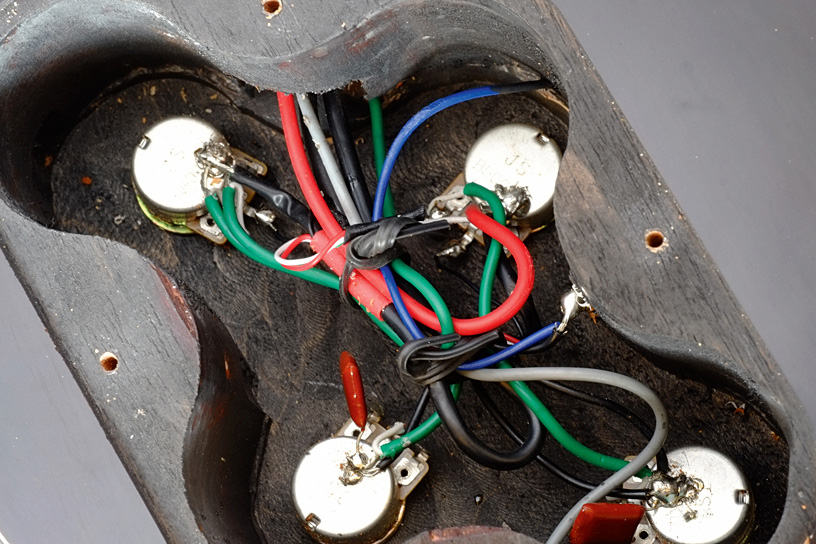
V100 Controls: Taking a look into the control cavities, the volume pots are small JS B500k (linear) and the tone pots are A500k tone (log or audio taper).
Most, of course, use log or audio taper pots for the volumes, some use linear pots for tones, though most still use audio taper for both. The caps are .047 microfarads (473 code); lighter .022 or .033 microfarads caps are more common.
The toggle switches on both are the typical import ‘box’ type. We can also see the wiring is modern style and the MP’s humbuckers are four-conductor, which means adding a coil-split would be easy via a switched pot.
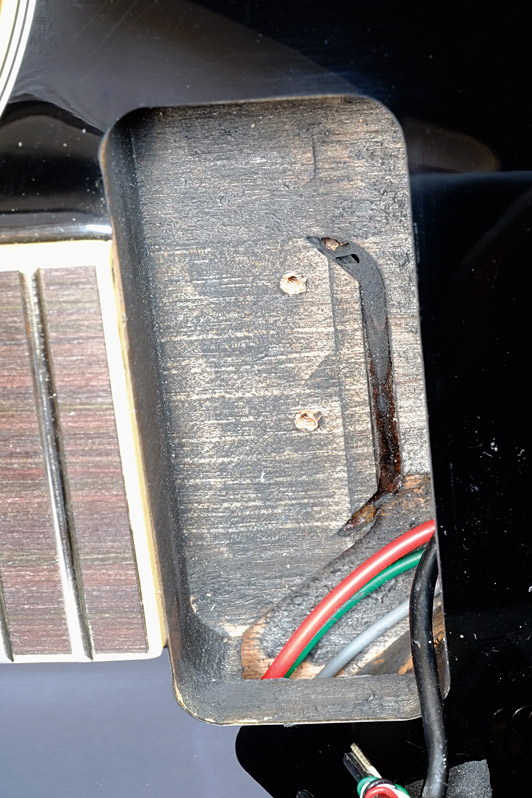
V100 Neck pickup cavity: While these guitars are far from vintage-spec clones of specific Gibson models, pulling out the neck pickup on both of them you can see a ‘long’ tenon neck join – the 42mm-wide neck tongue extends some 25mm into the pickup cavity.
It appears to be made of the right stuff, too, if colouration is anything to go by – and by just removing a little of the thin black conductive paint in the cavity you can see that the V100MP’s top is maple faced with a veneer, which is nothing to worry about at this price at all.
Both tune-o-matic and stud tailpieces are made by KD Rising Guitar, a hardware manufacturer based in China.
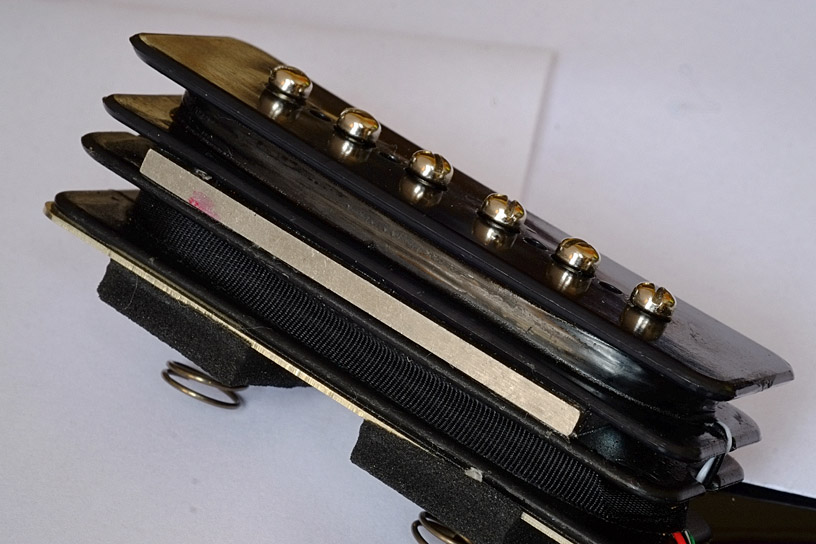
Wilkinson Stacked P-90: The PBB’s soapbars are stacked ’buckers. The standard P-90-style design has another coil underneath the two (ceramic) magnets. These pickups seem to be of a higher quality level, too – they are much cleaner looking and appear to have nickel-silver baseplates.
The MP’s bridge humbucker has a high DCR of 14.26kohm, which puts it into the Seymour Duncan JB or DiMarzio Super Distortion territory and is contrasted by the much more vintage-like neck pickup, which has a DCR of 7.47kohms. The PBB’s stacked soapbars also have pretty juicy DCRs, but these are the combination of both coils: 13.61k (bridge) and 11.64k (neck).
Feel & sounds
As with the design by which they’re inspired, both V100s are weighty propositions (there’s no mention of any weight relief ), but they do stay on the right side of the 4.5kg/10lb threshold and feel perfectly good in terms of playability, especially for the price. The fretwork is pretty tidy with the frets sitting over the binding, and it’s of a sensible gauge, too, not over-big in width or height at approximately 2.7mm wide and around 1.2mm high.
The PBB’s fret tops are slightly smoother (the fret work a little tidier, too); the MP’s feel a little scratchy, but nothing a quick rub won’t fix. The fingerboard edge – the binding, basically – has a nice in-turn to it and, although not specifically rolled, the top edges are far from sharp. Setups on both go for a pretty similar 1.6mm on both treble and bass sides, though the PBB is very slightly lower if we’re splitting hairs. While nicely cut in terms of height, both nuts could do with a little more fettling to cure the usual D and G string tuning issues.
As you’d expect, the necks of both models here feel very similar – a little narrow for the style, perhaps, but very similar in depth to Gibson’s Slim Taper. The MP measures 20.4mm at the 1st fret and 23.1mm at the 12th; the MP is marginally thinner at 20mm at the 1st fret and 22.8mm at the 12th. Gibson’s Slim Taper is slightly wider but similarly depth’d: a little over 20mm at the 1st and a shade over 23mm by the 12th.
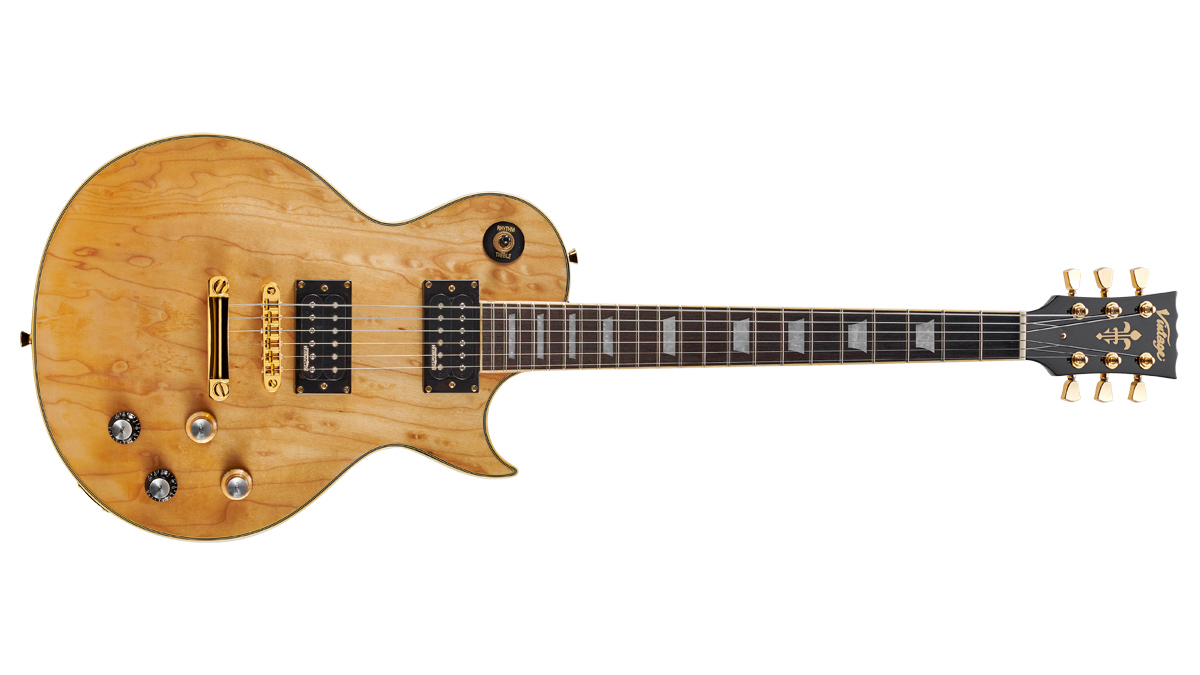
It’s probably fair to say that if you like your single-cuts running into a cranked and driven amp, you’ll have fun here. The MP just delivers ‘that’ sound. Like a Duncan JB, there’s power but it doesn’t sacrifice clarity: the neck pickup is very flutey in comparison and will easily have you gurning over your power ballad solos.
In a cleaner setting, those highs from the bridge and the strident power doesn’t make for the sweetest of bridge ’buckers we’ve ever heard, but even so there’s a punkier-edged crispness that you might enjoy. As ever, pull the controls back and things sweeten up quite nicely.
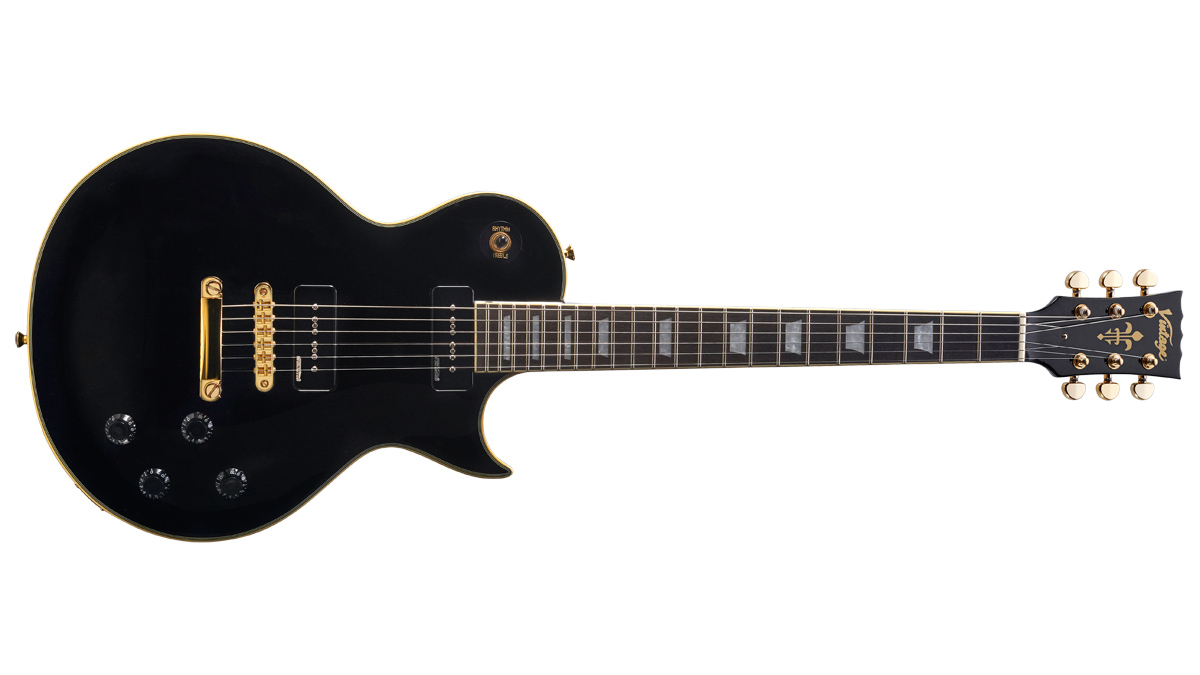
The PBB’s stacked soapbars don’t deliver the edgy and hotter single-coil voice we expected and in cleaner settings the highs are slightly muted with a noticeable midrange honk from the bridge pickup.
The neck works better for us, but still has us reaching for the tone to add the clarity we’d expect, though the slightly rounded response is a rather good fusion-jazz voice. Switch to something more driven and the PBB delivers in spades with an appealing smoothness. The stacked design doesn’t completely lose pick-up hum, though, unless you’re in middle, both pickups on.
It’s like a good Gibson Junior or Special with the tones knocked back quite a bit – and that’s no bad sound. The control taper choice (see Under The Hood on the previous page) does seem a little odd. Whereas our original Les Paul Junior cleans up really well with only a slight volume reduction, here the volume control taper is much more gradual and you have to wind it back some way to achieve that duality. The tone capacitor is too heavy to leave any clarity as you wind it down, too.
From their hybrid Standard/ Custom style to their rock-ready voices and a playability that’s more than acceptable out of the box, so long as you prefer a skinnier neck
The MP is little different in that regard and it’d be nice to hear both these pickup sets with a more flattering control setup. With a very unified feel, these two do sound quite different. The MP really wants to rock and while the PBB doesn’t quite capture the P-90 voice we’d expected, it’s got its own thing going on: smooth yet clear, a surprisingly sophisticated voice.
Verdict
If the purpose of a copy is to provide a taste of the real thing at a way more affordable price point then both these V100s pass that test in some style.
Yes, they sit on the heavier side in weight – and actually in sound, too – and are let down a bit by wiring that isn’t maximising the potential. But the longer we spent with this cut-price duo, the more we enjoyed them: from their hybrid Standard/ Custom style to their rock-ready voices and a playability that’s more than acceptable out of the box, so long as you prefer a skinnier neck.
That Vintage logo might not be the coolest we’ve seen, but it’s not a deal-breaker and we’d strongly suggest you try either of these alongside the obvious competition, not least Epiphone. Do they hold their own? We think so.
Specs
Vintage Reissued V100PPB
- PRICE: £429
- ORIGIN: China
- TYPE: Single-cutaway, solidbody electric
- BODY: Mahogany with carved maple top
- NECK: Mahogany, glued-in
- SCALE LENGTH: 627mm (24.7”)
- NUT/WIDTH: Graph Tech NuBone XB/42.3mm
- FINGERBOARD: Single-bound Lignum Rosa, trapezoid inlays, 305mm (12”) radius
- FRETS: 22, medium jumbo
- HARDWARE: Wilkinson tune-omatic-style bridge, stopbar tailpiece, enclosed tuners– gold-plated
- STRING SPACING/BRIDGE: 52mm
- ELECTRICS: 2x Wilkinson W90 SK single-coil soapbars, 3-way toggle pickup selector switch, volume and tone for each pickup
- WEIGHT (kg/lb): 4.3/9.46
- OPTIONS: None with this pickup configuration. With twin-humbuckers and gold hardware the all-black V100BB is £399
- RANGE OPTIONS: The V100 range kicks off with the NBTSB (£339); flame-top versions cost £399. The three-humbucker V1003 comes in Cherry Sunburst (£379), Arctic White and Boulevard Black (£429)
- LEFT-HANDERS: No
- FINISHES: Gloss black (as reviewed)
Vintage Reissued VM100MP
- PRICE: £399
- ORIGIN: China
- TYPE: Single-cutaway, solidbody electric
- BODY: Mahogany with carved maple top
- NECK: Mahogany, glued-in
- SCALE LENGTH: 627mm (24.7”)
- NUT/WIDTH: Graph Tech NuBone XB/42.07mm
- FINGERBOARD: Single-bound Lignum Rosa, trapezoid inlays, 305mm (12”) radius
- FRETS: 22, medium jumbo
- HARDWARE: Wilkinson tune-o-matic-style bridge, stopbar tailpiece, Grover 102 tuners with keystone buttons – gold-plated
- STRING SPACING/BRIDGE: 52mm
- ELECTRICS: 2x Wilkinson WOHHB uncovered humbuckers, 3-way toggle pickup selector switch, volume and tone for each pickup
- WEIGHT (kg/lb): 4.44/9.77
- OPTIONS: None with this pickup configuration
- RANGE OPTIONS: Other artist-inspired models include the V100PGM Lemon Drop (£449), the V100AFD (£439) and the V100 Midge Ure (£499)
- LEFT-HANDERS: Not this model, but LV100s start at £399 in a choice of colours
- FINISHES: Natural – maple gloss (as reviewed)
- Vintage Guitars

Dave Burrluck is one of the world’s most experienced guitar journalists, who started writing back in the '80s for International Musician and Recording World, co-founded The Guitar Magazine and has been the Gear Reviews Editor of Guitarist magazine for the past two decades. Along the way, Dave has been the sole author of The PRS Guitar Book and The Player's Guide to Guitar Maintenance as well as contributing to numerous other books on the electric guitar. Dave is an active gigging and recording musician and still finds time to make, repair and mod guitars, not least for Guitarist’s The Mod Squad.
